155 Main St., Hulett, Wyoming
Gallery: 307-467-5849
Cell: 805-400-7706
AMERICAN INDIAN ITEMS FOR SALE
Contact Bob bcoronato@msn.com or call my cell 805-400-7706
All Questions Welcome!
Please request photos of currently available items. Most on the site have been sold
We have many Individule items and entire finished MUSEUM READY MOUNTS AVAILABLE
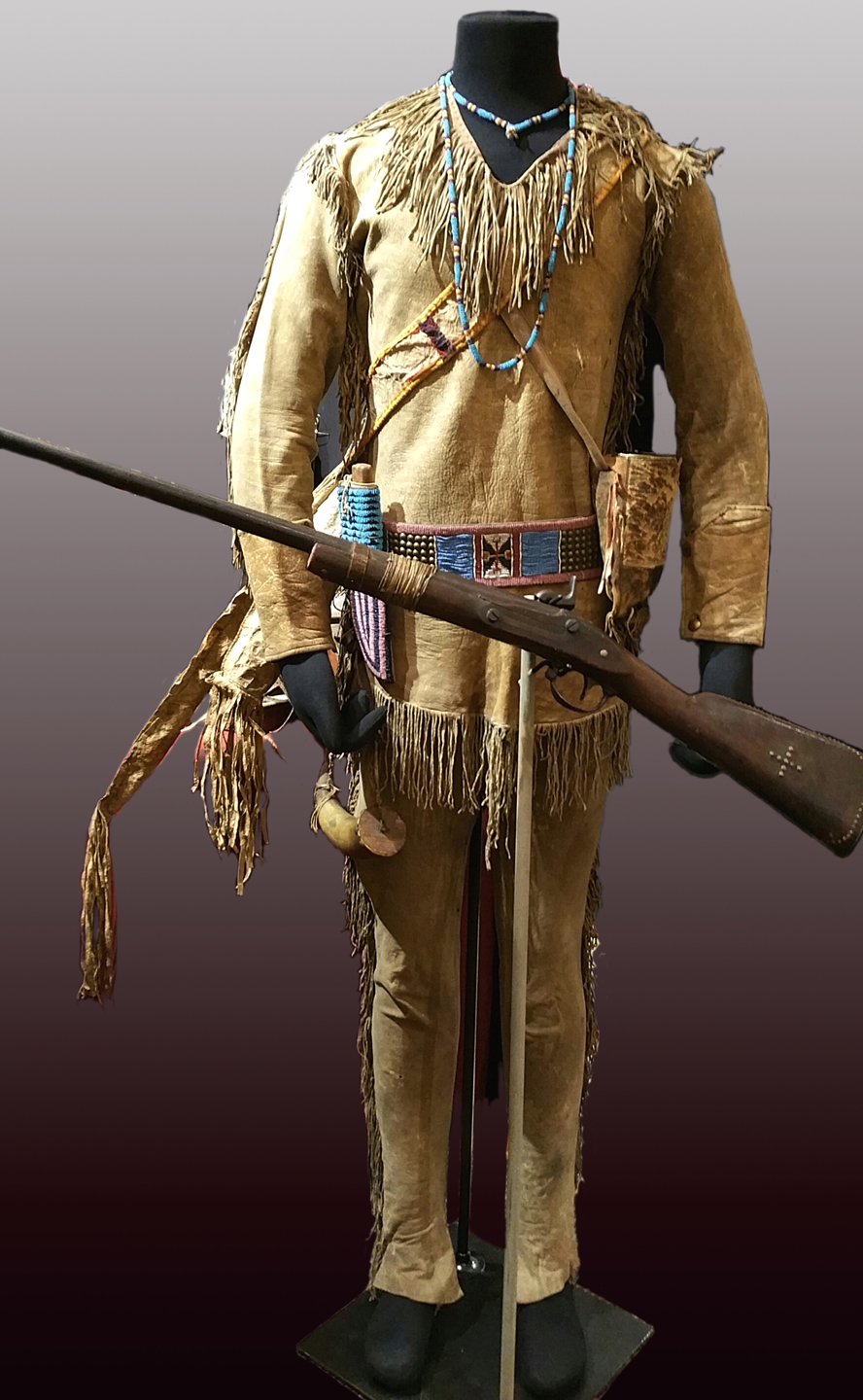
This 1860-1870’s outfit is complete with hide shirt and matching leggings, Bow case and quiver, tacked and beaded belt with early knife sheath, Plains Indian Made Binocular case, tacked cut down 1840’s Harpers Ferry Indian modified rifle.
The style of the outfit indicates a military scout or possibly early fur trader. The patina and hard use show how life was on the plains in the early west. Many Indians were hired by the military as scouts to help as they traveled through hostile areas.
Scout Outfit Consists of :
Plains Beaded Knife Case
1860’s- 1870’s
Beaded with seed beads traded from Italy on indian tanned hide that is applied to parfleche hide. The parfleche hide shows paint designs, and that means it
was cut from a parfleche envelope. Recycling old parts from other items was common among the plains. Nothing was left to waist when materials were hard to come by.
Beaded and Tacked Belt
c.1860-1870
Indian Tacked Powder Horn
ca 1840-1860’s
Showing signs of typical of the Plains Indians using
brass tacks to decorate, and a small attachment of Native tanned hide attaches it to the commercial hide strap.
1841 Indian Modified Springfield
.69 cal
The large caliber would be for hunting buffalo and warfare out west .
Starting off as a flintlock that was changed to percussion and traded out west. After the horse was on the Plains and more common for warfare the rifles were cut down by Indians into a carbine. The gun shows high polish from use, great patina overall. The brass and copper tacks are all over the top, running round the butt to the bottom and across the bottom. There is a classic (cross) or four directions design on one side. Typical copper repairs added to the gun as it was used hard. The barrel was cut off and typically the remaining piece would have been turned into a hide scraper. this gun also shows makes around the end of the barrel where it was etched possibly ownership marks.
The gun was on display in the charging bear museum in browning montana, then at the Custer Battlefield Museum
Rare Plains Binocular Case
1860’s- 1870’s
Binocular case made from commercial hide and Indian Brain Tanned hide.
Fringed with Indian tanned hide fringe and traces of red vermillion trade paint.
Early Plains Bow Case and Quiver
1850’s- 1870’s
Bow case is made from early buffalo hide, with traces of paint doting along the tabs. The dots generally mean hail,…and give the owner the spiritual power of hail to “rain down hail upon my enemy” The Bow case shows heavy use and great patina that only comes from everyday use and warfare. There are traces of red paint along the hide that probably were transferred as many warriors painted themselves with red vermillion.
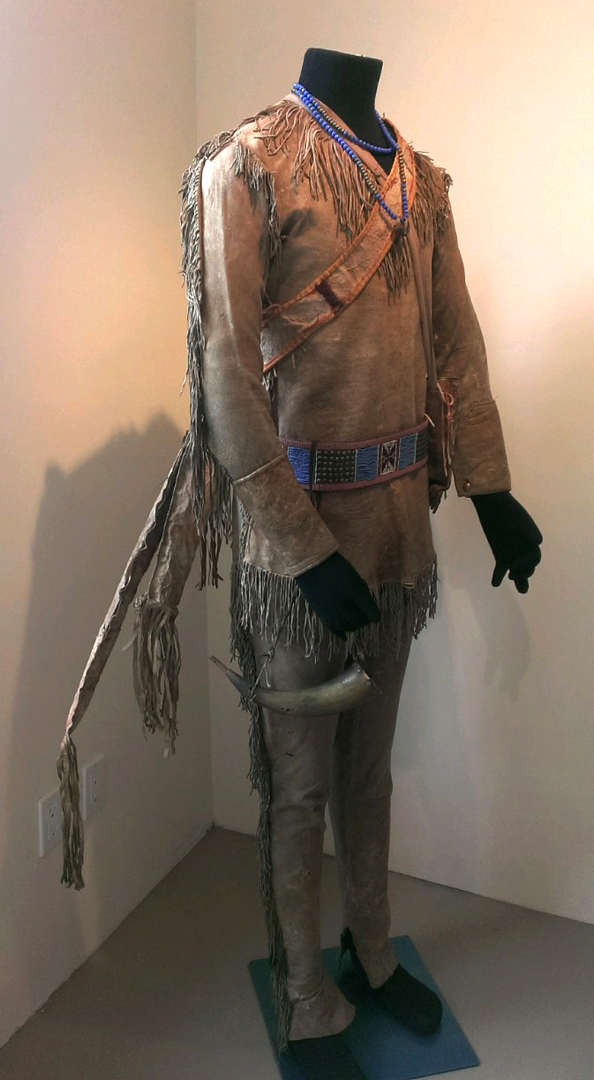
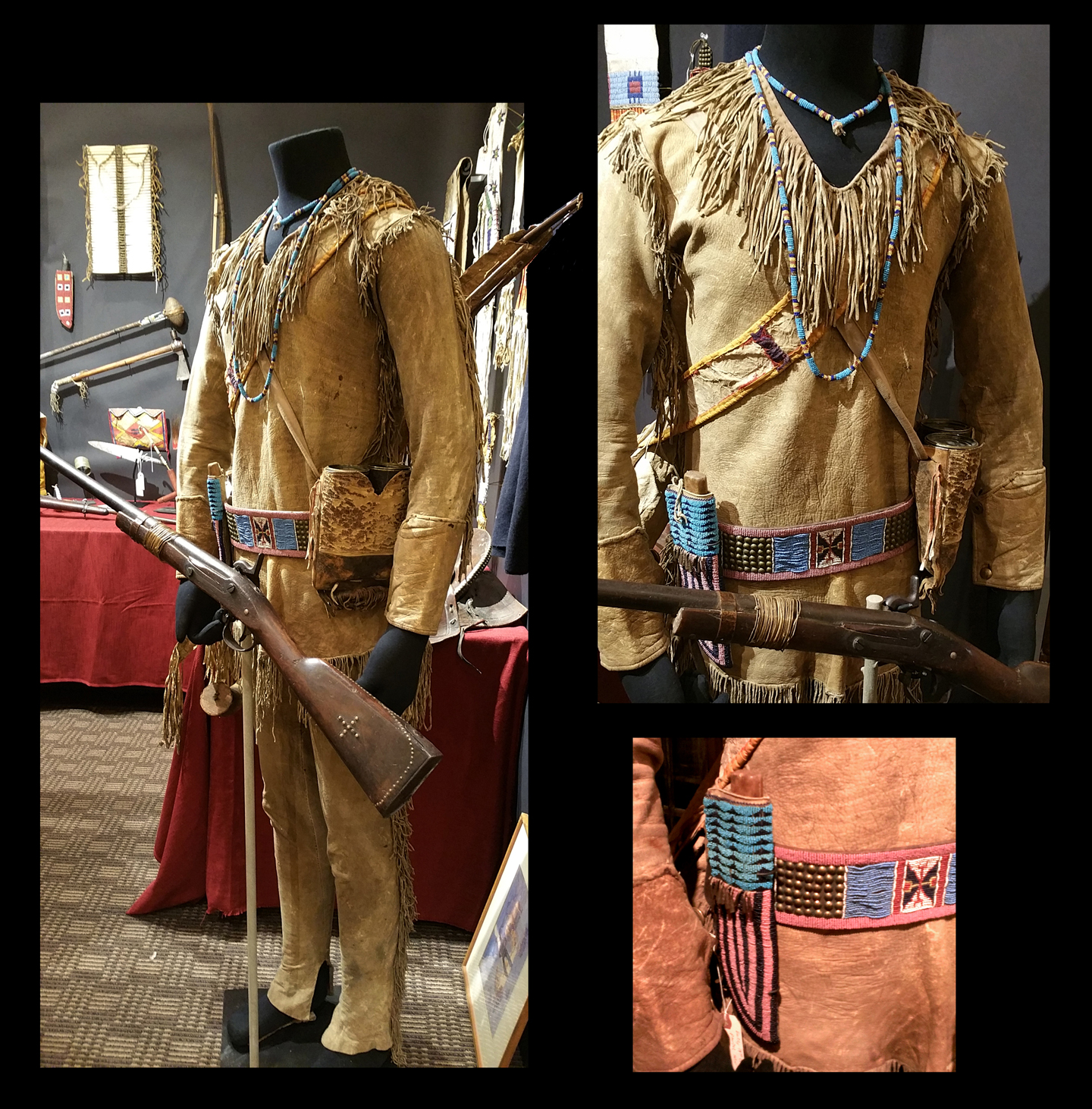
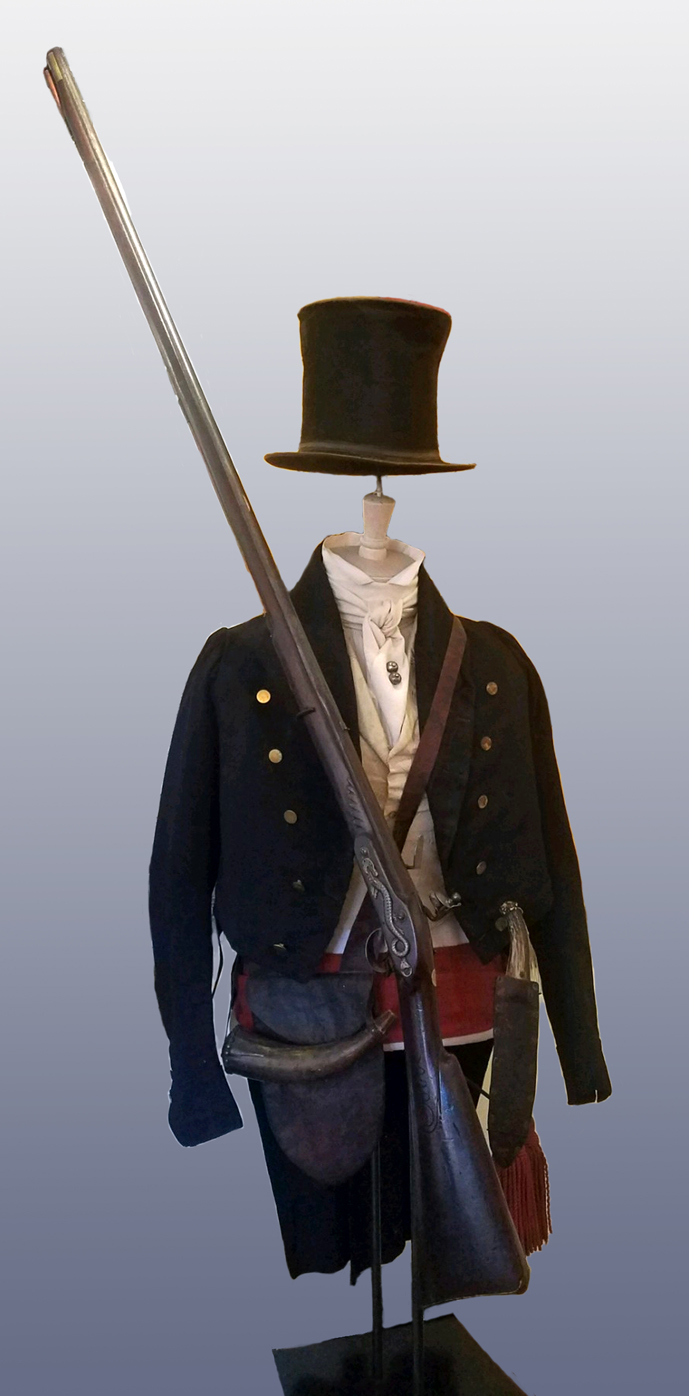
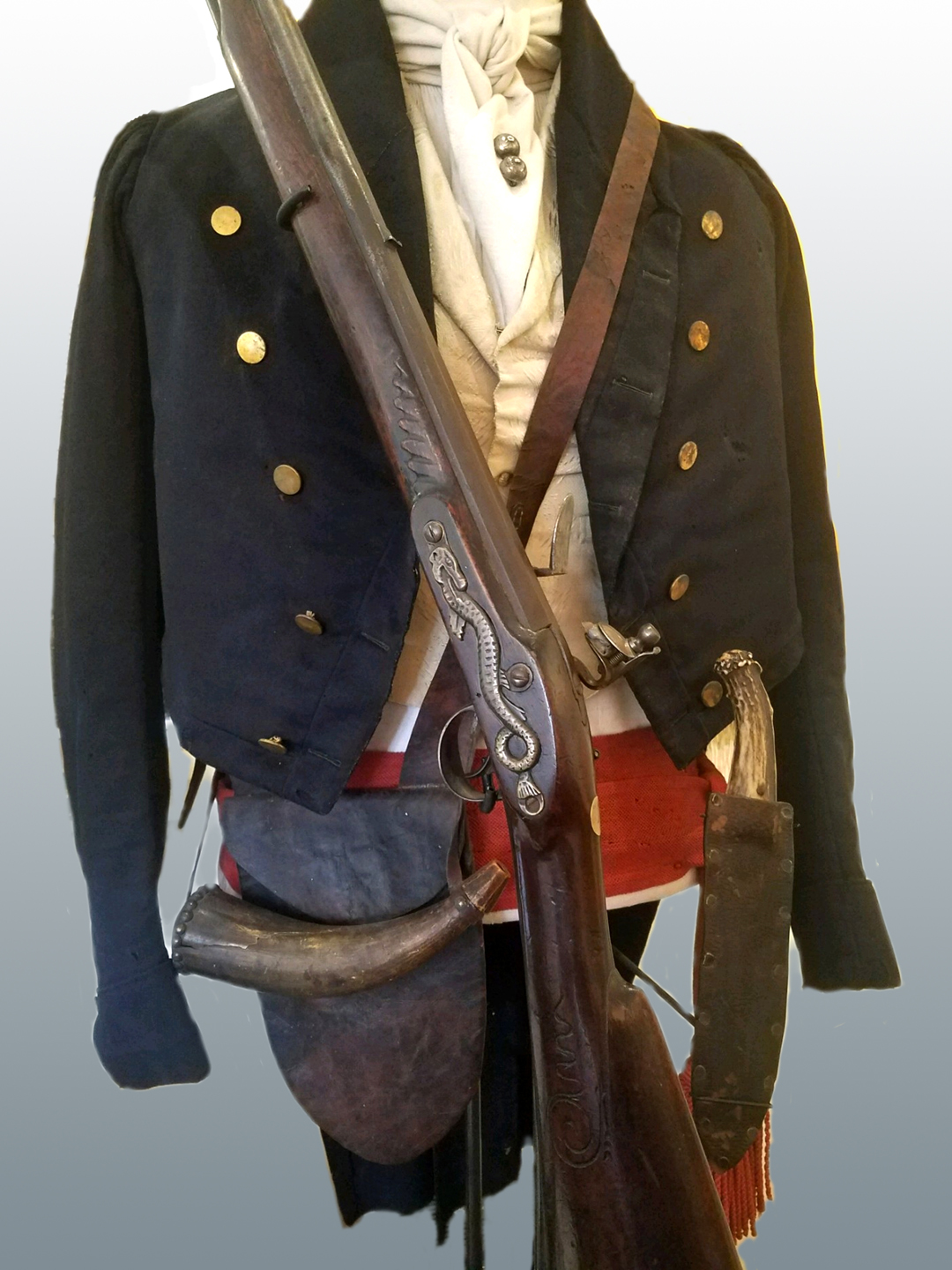
outfit includes: natural linen shirt with regency era tall white linen collar, regency era waistcoat (vest) and cravat. Cravat linen was home spun, woven by A.Prentice . Her initials woven into cloth c.1790 – 1800 regency era cravat pin with silver makers hallmark. Regency era every day wear wool coat, beaver fur top hat, hunting pouch and powder horn c. 1790 Early fur trade frontier knife and sheath. Knife c. 1800 has a deer antler handle and early ridged dag style blade. Knife sheath made from beaver tail and lead rivets. Rare chiefs grade (brass hardware) flintlock with serpentine side-plate made for the American Indian Trade by T. Ketland.
T. Ketland made guns for the North West Company and Hudson’s Bay from 1760 – 1816
“The Chiefs grade” smoothbore guns presented to various Native Americans by British agents in the early 19th century especially before and during the War of 1812. Though generally categorized as “trade guns” these weapons are really separate entity from other trade guns in that they were used diplomatically rather than for commerce. Exchanging gifts was an important part of alliance building and maintenance for many Indian Nations, and gifts were often lavishly presented by European powers at treaties to both display the colonial powers wealth, and generosity.
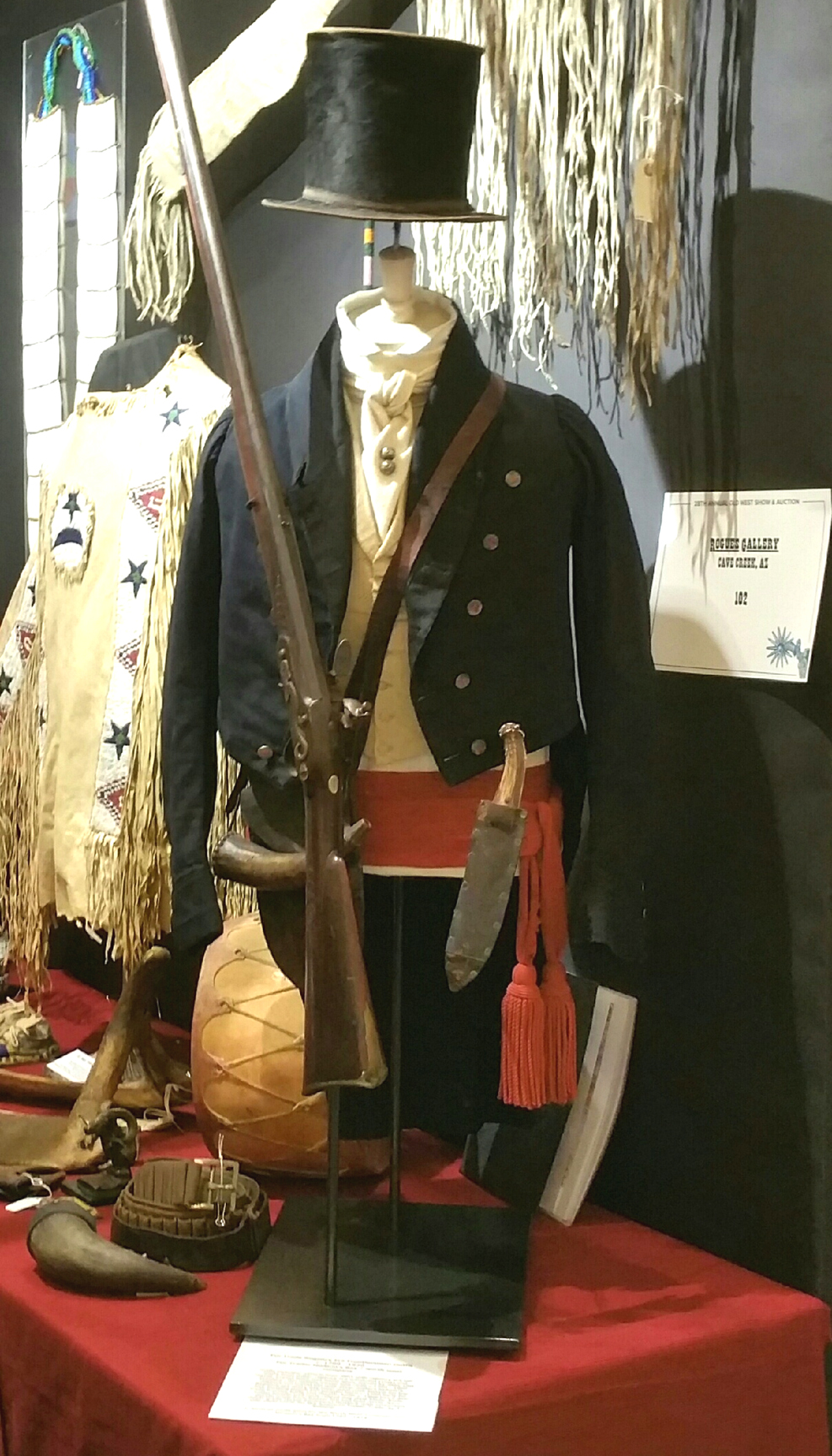
Moccasins belonging to Wirlwind Soldier

19th c. Sioux Gunstock War Club
This exceptional club has a Morning Star cut out and the shoulders of the blade have been filed down. Morning Star symbolizes hope and guidance. it has meanings related to past spirits and ancestors. By using the symbol they might gain the power of the spirits to perform great exploits in hunting and war.
The club has an antelope hide wrap for grip and lighting power marks carved into the handle.




19th c. N. Plains Knife Case and 5 pin Trade Knife

Crow Mans Elk Hide Wearing Robe / Blanket Strip ca 1870's

Rare Three Blade Gunstock Club

H. E. Leman Tacked Indian Trade Rifle
Exceptional Indian gun with a dragonfly tacked into the stock, and a small engraved pictograph of a thunderbird in the brass patch box.


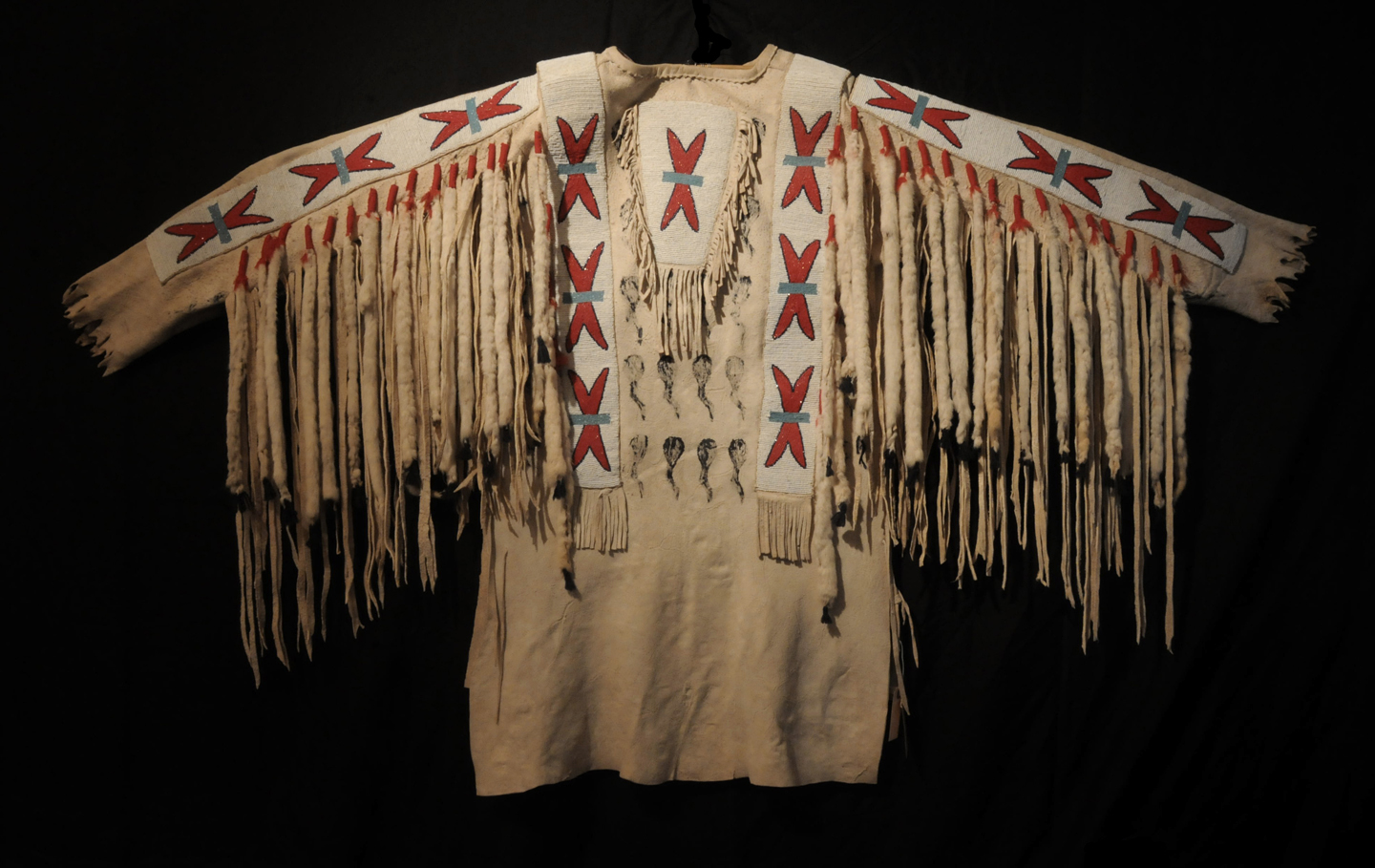
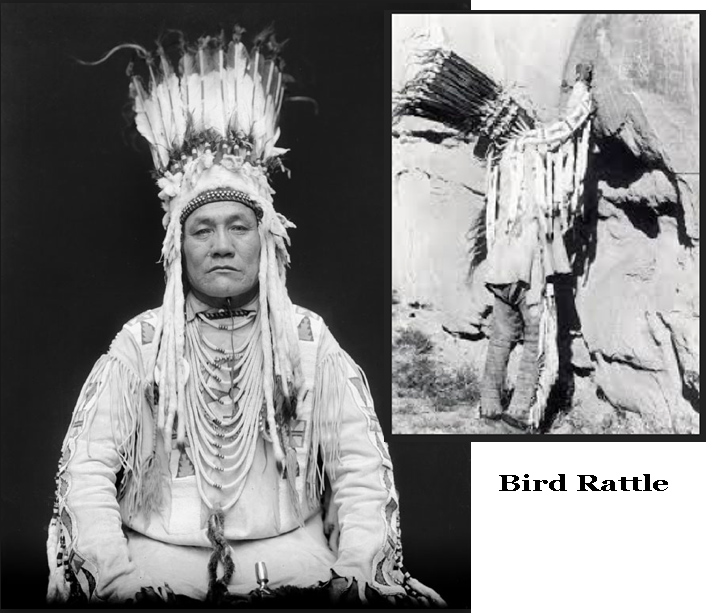

This shirt was collected in 1903 from Bird rattle a very respected Blackfoot warrior, medicine man and judge for the Pikunni (blackfoot) people. He had over 35 horse raids on the Crow people including one where he stole a entire herd. He also stole the prized Crow Buffalo Horse, the fastest horse among the Crow people. Along with the horse he stole a shield and feather bonnet, huge honors among his people. Bird Rattle also known as Bird Rattler kept this prized horse and trained it to race, and won many more honorsas a famous winner. Bird Rattler also had exploits of war on the Cheyenne, stealing Horses, Woman and a travois with guns. Later in life he was the keeper of the Circle – dance medicine pipe bundle. The shirt has collection info including the date of 1903.
Sioux Shield ca 19th c.
Morning star painted on yellow ochred hide.

Lakota Pipe Tomahawk ca. 1860's - 1870's

Exceptional pipe tomahawk with finely carved and painted haft. The patina is a mellow golden color with brass tacks, brass wire and file burned accents.
The drop is original and has brass french trade beads. This is a Extremely Fine work of art, with all the bells and whistles. the intake is a rim fire henry shell case, that dates to the 1870’s.
Captured Pictographic Indian Winchester Carbine 1866
Intials most likely from a Army/Cavalry trooper have been carved into the reciever after a warrior had engraved a horse and grizzly bear into the brass. The rocker engraving is early Plain Indian done, most likely Crow or Lakota, The winchester pre dates the custer battle, and judging by the intials put in after it was rocker engraved, leads one to believe it was captured.


Northern Cheyenne Tobacco Bag ca 1870 's
The Parfleche slats were never quilled and are early buffalo hide with heavy dark dermis and patina.

Dakota Pipe Tomahawk ca. 1870's- 1880's
 Detail Photo
Detail Photo

19th Century Plains Indian Stone War Clubs

Indian Wars Period Moccasins

Acoma olla ca. 1900 - 1920

Ft. Peck Sioux War Shirt ca. 1880's
Nice early War shirt ca 1880’s on a very fine thin indian tanned antelope hide. Two piece construction, sinew sewn and great early bead stripes.
100% all original to the piece.

Indian Guns

- Cut down rifle with indian made ram rod.
Shows signs of rawhide wrap and tacks.
Rifle is in relic condition. - 1841-1842 Rifle.
This indian gun collected off the Lower Brule, shows great patina, repairs and is a good example of an Indian gun from the period. The tacks are cast square shank tacks, few of them look to be round, shows great age. The rawhide wrap is sinew sewn but has split at the seams from age. The stock was also repaired with copper. Great Gun. - 1841 Springfield cut down and tacked.
This came out of a very old museum in Montana. Charging Bear Museum.
Shows great age and patina and the barrel is etched or filed on the end as a sign of ownership or design element. - Cut Down Remington Rolling Block.
This is an 1874 model with the barrel cut down using a file turned on its edge.
Honest wear and tacks, shows hard use.

- 1864 Parker Snow
Cut down and shows heavy saddle wear. (olmost worn down to the barrel through ram rod. The repairs are old and has just a couple old tacks.
The butt plate was removed and the gun is worn smooth. Came out of old Cavalry Museum in South Dakota. - 1863 cut down rifle.
shows great heavy use, file marks and awesome patina. The stock was crudely cut with a knife and then filed. great Indian hard use. lots of cast tacks, and an odd repair with the for-stock from a different gun. heavy use and old repairs. - Third modle Winchester ca 1881
Found on the Northern Cheyenne Indian Reservation near Lame Deer. Out of John Dumontt estate. He wrote the book on Custer Battle Guns. Shows heavy use and lots of saddle wear. Has a nice honest frontier patina from heavy use.
Sharps 1859 Carbine Indian Gun
Sharps model 1859 Carbine
Great Honest Indian Carbine with heavy, heavy frontier use. Shows deep saddle wear and the wood has been worn down around the front ring. The tacks were worn off or just small tacks, but show great patina and slick smooth wear from years of hard use. the gun functions fine, a Great example of an indian gun, That saw lots of Indian War action.
Awesome example of a early Indian Gun.

Apache War Shirt ca. 1890
Apache Shirt ca.
1890 sinew sewn and beaded with 1890’s era beads. red beads are transparent.
Red, and beads are in great shape, no bead loss.
Nice old patina on brain tanned hide with tabs and elbow fringe.

Plains Quilled Tepi Bag ca. 1870-1880's
The photo shows a similar bag inside a tepi ca mid 19th century.

19th century Tepi Backrest and Carved poles from Two Guns White Calf

Crow or Blackfeet Scout Shirt ca 1860 - 1870
Crow or Blackfeet scout shirt ca. 1860-1870
The shirt was sold years ago through Fenn Gallery and still has the tag.
Nice shape with no noticeable bead loss. Has nice frontier look, and lots of patina.

Early Scout Shirt and Pants ca. 1860'- 1870's s (or earlier)
- This scout shirt and Pants was very heavily used. Shows horseback wear throughout the pants. just like the scout in the famous painting by Frederick Remington, this saw frontier use, and looks identical to the one in the painting. Some military buttons on cuffs, but earlier ones as well. nice fringe that retains soft feel.
- Sioux Trade Wool Leggings ca. 1870-1880
Nice leggings with metal sequins, great bead stripes and the blue stroud trade wool, in perfect condition. The sripes are sinew/thread sewn with rose heart red beads.
Indian weapons

- Cut down rare Remington Maynard tape conversion.
The gun started out as a post Rev. war era rifle then traded out west and cut down by an American indian. to be used as a shotgun, or “Blanket Gun”.
The cut down stock is crudely done and shows heavy use. Old old cut down, probably 1860-s or earlier, with the amount of patina. The stock has copper nails in it, on two sides, but Im not sure as to the date of the nails.
Nice Indian gun with a rare style primer. - Nice Early Sioux Knife Sheath with orig. knife.
The Knife Case was collected on Pine Ridge and has old newspaper Article inside loosly describing the knife as a gift. nice early buffalo hide with parfleche liner.
Knife is sharpened only on one side, the early Indian Way.
Plains Indian Mans Breastplate ca. 19thc.


- Wide early Sioux bow very similar to the one in the photo of Chief Gall. Painted geen on the front and striped with natural red and blue paint on the reverse.
original string, plus one buffalo era arrow that came with. - Early N. Plains re -curve bow ca. 1840- 1860’s with sinew on the front of the bow. dark patina, original sinew string.
- 1860-1870s stone war club with red vermillion rubbed on the rawhide shaft. longer handle for fighting horseback, some beadwork at the top and around the stone.
- 1860-1870’s Sioux Straight bow published in a book in the 50’s – 60’s ex miles collection. pictured in the book, and covered with heavy mellow patina. nice thick ashe war bow.
- Northern Plains ashe bow ca. 1860-1870
No string, but heavy smooth patina and great curved shape. 650.00
Moccasins and Plains Beaded Items

- Red Sioux Moccasins ca 1890
- Cheyenne woman’s moccasins with leggings ca 1880
- Blacfeet Leggings ca. 1890
From the collection of a well known artist, the leggings are soft with great wide fringe. - Blue background Sioux Kife case with Knife. the case is ca. 1880’s on buffalo hide.
Sinew sewn, with drop and tin cones, red horse hair.
Nice “dragon fly” design on the front. - Sioux beaded child’s moccasins
“Cerimonial” beaded on the bottoms
Sinew and thread sewn ca 1880-1890 - Cheyenne partial beaded moccasins on very soft brain tanned antalope smoked tanned hide. ca 1870-1890’s
- Crow Lumpwood Society quirt ca 1890- 1900
From the collection of Custer Battlefield Trading Post - Apache recurve bow ca 1870-1880
- Rare Indian owned powder horn set
Large horn has red vermillion “warriors color” painted on the wood end
The med size horn has a small sinew repair on the pooring end and the shot pouch has great patina and still has one bullet inside.
Collected from South Dakota and *****rare to have such absolute certainty that it was used and carried by an American Indian pre Indian Wars era. - 1870-1890 Dakota carved Pipe and Stem
Finely carved with painted and file burned stem.
Super rare fine carved stem, from old collection in England. - Small Pipe and Pipe bowl with figures and animals carved on the bowl.
ca. 1870-1880
Nice patina and old smoked bowl with ash stem.

- Fantastic Sioux flag pictoral leggings with tin cones ca. 1890
Great bead colors and mans moccasins on buffalo hide. - Mandan Quilled Elk Dreamer Moccasins ca 1880-1890
- Trade bronze peace medal (age possibly 1900)
I have no way to date the medal other than the patina looks natural and has some natural wear. cam in a beaded pouch ca 1900, and looks to be real. I know the early ones were silver and later ones were bronze, they are still made today and hard to date. based on the wear and patina, I would guess that its a real peace medal from the turn of the century.
N.Plains Moccasins ca. 1880's
A very finely beaded pair of mans moccasins on buffalo hide. The beads are red white hearts, cobalt,white, greesy yellow. The artistry of the maker was pollished and a high level of skilled hands beaded these. The natural yellow ochre accents finish off these striking pair of Northern Plains moccasins.

Wasco Parfleche Envelope ca. 1880-1890
Very nice painted parfleche envelope with painted inside flaps.
The artwork is finely done with a nice attention to detail. Patina is excelent and the trade paints are good older colors.

Porcupine Quilled Elk Dreamer Hidatsa/ Mandan ca 1890

Cheyenne or Sioux Indian DENTALIUM SHELL DRESS
STUNNING! PICTURE DO NOT DO THIS PIECE JUSTICE!!! 1870- 1890’s Very Old Northern Plains Indian, Cheyenne, or Sioux women’s full size dress. Beautiful Dark blue wool with white salvage edge design. Covered in hundreds of dentalium shells around the top. Some shells are sewn down with SINEW, but most with very old thread. The bottom edge of the dress has great old metal sequins used in circle and triangle designs. The top has nice old dark silk ribbon ties. No moth holes. Very few missing shells and sequins. This dress is in great condition for it’s age and would make a Great Addition to your collection. Size is 48″ long x 36″ across at arms x 36″ across at bottom of dress.
Early buffalo hide Navajo rattle.
Incised with lighning and painted with red and green vermillion.
Handle is wood with brain tanned hide wrap.
Good example of an early rattle.
Recently Sold

Childs Cheyenne Mocasins ca 1880

Sioux Womans Moccasins ca. 1890
Womans moccasins beaded on hide with sinew. They were owned and worn by sileght film star Claire McDowell and are pictured in a hand colored photo ca. 1910. claire appeared in over 360 films from 1908 to 1945.


Recently Sold Items
Hand Carved Antique Tarahumara Indian Violin w/ Horse hair Bow strings. It still has one of it’s sinew violin strings, the others have been replaced years ago by wire. Painted with green vermillion paint around cut out designs on the front. Amazing head carved into the top of the violin, I believe it’s an eagle. My guess is it’s from the turn of the century, shows great age.
Violins were introduced to the Tarahumara by the Spanish missionaries in the 1600’s. Since then, the Tarahumara have been hand carving these instruments. A talented Tarahumara musician is believed capable of communicating with divine beings and able to request good fortune from them.
Size of violin is 2 feet tall x 9 inces at widest part. The bow is 26 inches long. GREAT PATINA!!!
